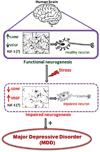Role of trophic factors GDNF, IGF-1 and VEGF in major depressive disorder: A comprehensive review of human studies
- PMID: 26956384
- PMCID: PMC4837031
- DOI: 10.1016/j.jad.2016.02.067
Role of trophic factors GDNF, IGF-1 and VEGF in major depressive disorder: A comprehensive review of human studies
Abstract
Rationale: The neurotrophin hypothesis of major depressive disorder (MDD) postulates that this illness results from aberrant neurogenesis in brain regions that regulates emotion and memory. Notwithstanding this theory has primarily implicated BDNF in the neurobiology of MDD. Recent evidence suggests that other trophic factors namely GDNF, VEGF and IGF-1 may also be involved.
Purpose: The present review aimed to critically summarize evidence regarding changes in GDNF, IGF-1 and VEGF in individuals with MDD compared to healthy controls. In addition, we also evaluated the role of these mediators as potential treatment response biomarkers for MDD.
Methods: A comprehensive review of original studies studies measuring peripheral, central or mRNA levels of GDNF, IGF-1 or VEGF in patients with MDD was conducted. The PubMed/MEDLINE database was searched for peer-reviewed studies published in English through June 2nd, 2015.
Results: Most studies reported a reduction in peripheral GDNF and its mRNA levels in MDD patients versus controls. In contrast, IGF-1 levels in MDD patients compared to controls were discrepant across studies. Finally, most studies reported high peripheral VEGF levels and mRNA expression in MDD patients compared to healthy controls.
Conclusions: GDNF, IGF-1 and VEGF levels and their mRNA expression appear to be differentially altered in MDD patients compared to healthy individuals, indicating that these molecules might play an important role in the pathophysiology of depression and antidepressant action of therapeutic interventions.
Keywords: Biomarker; GDNF; IGF-1; Major depressive disorder; Neurorophin; Trophic factors; VEGF.
Published by Elsevier B.V.
Similar articles
-
Value of peripheral neurotrophin levels for the diagnosis of depression and response to treatment: A systematic review and meta-analysis.Eur Neuropsychopharmacol. 2020 Dec;41:40-51. doi: 10.1016/j.euroneuro.2020.09.633. Epub 2020 Sep 24. Eur Neuropsychopharmacol. 2020. PMID: 32980240
-
The Role of Neurotrophic Factors in Pathophysiology of Major Depressive Disorder.Adv Exp Med Biol. 2021;1305:257-272. doi: 10.1007/978-981-33-6044-0_14. Adv Exp Med Biol. 2021. PMID: 33834404
-
Plasma glial cell line-derived neurotrophic factor in patients with major depressive disorder: a preliminary study.Acta Neuropsychiatr. 2016 Feb;28(1):45-50. doi: 10.1017/neu.2015.42. Epub 2015 Jun 30. Acta Neuropsychiatr. 2016. PMID: 26122261
-
Association between plasma levels of BDNF and GDNF and the diagnosis, treatment response in first-episode MDD.J Affect Disord. 2022 Oct 15;315:190-197. doi: 10.1016/j.jad.2022.07.041. Epub 2022 Jul 28. J Affect Disord. 2022. PMID: 35908604
-
Significantly Higher Peripheral Insulin-Like Growth Factor-1 Levels in Patients With Major Depressive Disorder or Bipolar Disorder Than in Healthy Controls: A Meta-Analysis and Review Under Guideline of PRISMA.Medicine (Baltimore). 2016 Jan;95(4):e2411. doi: 10.1097/MD.0000000000002411. Medicine (Baltimore). 2016. PMID: 26825882 Free PMC article. Review.
Cited by
-
Integrating Metabolomics and Network Pharmacology to Explore the Mechanism of Xiao-Yao-San in the Treatment of Inflammatory Response in CUMS Mice.Pharmaceuticals (Basel). 2023 Nov 14;16(11):1607. doi: 10.3390/ph16111607. Pharmaceuticals (Basel). 2023. PMID: 38004472 Free PMC article.
-
Human Fetal Bone Marrow-Derived Mesenchymal Stem Cells Promote the Proliferation and Differentiation of Pancreatic Progenitor Cells and the Engraftment Function of Islet-Like Cell Clusters.Int J Mol Sci. 2019 Aug 21;20(17):4083. doi: 10.3390/ijms20174083. Int J Mol Sci. 2019. PMID: 31438545 Free PMC article.
-
Vascular Endothelial Growth Factor as a Putative Biomarker of Depression in Asthmatics with Reversible Airway Narrowing.J Clin Med. 2021 Nov 15;10(22):5301. doi: 10.3390/jcm10225301. J Clin Med. 2021. PMID: 34830591 Free PMC article.
-
Type A monoamine oxidase and serotonin are coordinately involved in depressive disorders: from neurotransmitter imbalance to impaired neurogenesis.J Neural Transm (Vienna). 2018 Jan;125(1):53-66. doi: 10.1007/s00702-017-1709-8. Epub 2017 Mar 14. J Neural Transm (Vienna). 2018. PMID: 28293733 Review.
-
Insulin-like growth factor-1: a possible marker for emotional and cognitive disturbances, and treatment effectiveness in major depressive disorder.Ann Gen Psychiatry. 2017 Oct 26;16:38. doi: 10.1186/s12991-017-0161-3. eCollection 2017. Ann Gen Psychiatry. 2017. PMID: 29093741 Free PMC article. Review.
References
-
- Bach MA, Shen-Orr Z, Lowe WL, Jr, Roberts CT, Jr, LeRoith D. Insulin-like growth factor I mRNA levels are developmentally regulated in specific regions of the rat brain. Brain Res Mol Brain Res. 1991;10(1):43–48. - PubMed
-
- Berent D, Macander M, Szemraj J, Orzechowska A, Galecki P. Vascular endothelial growth factor A gene expression level is higher in patients with major depressive disorder and not affected by cigarette smoking, hyperlipidemia or treatment with statins. Acta Neurobiol Exp (Wars) 2014;74(1):82–90. - PubMed
-
- Carvalho AF, Kohler CA, McIntyre RS, Knochel C, Brunoni AR, Thase ME, Berk M. Peripheral vascular endothelial growth factor as a novel depression biomarker: A meta-analysis. Psychoneuroendocrinology. 2015;62:18–26. - PubMed
-
- Carvalho LA, Bergink V, Sumaski L, Wijkhuijs J, Hoogendijk WJ, Birkenhager TK, Drexhage HA. Inflammatory activation is associated with a reduced glucocorticoid receptor alpha/beta expression ratio in monocytes of inpatients with melancholic major depressive disorder. Transl Psychiatry. 2014;4:e344. - PMC - PubMed
Publication types
MeSH terms
Substances
Grants and funding
LinkOut - more resources
Full Text Sources
Other Literature Sources
Miscellaneous


